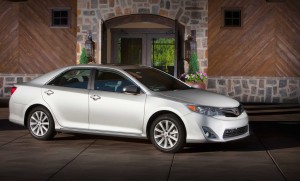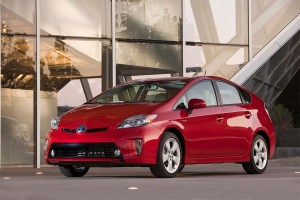
Toyota has sharply reduce the average transaction price of the Camry sedan in recent months hoping to prop up sales.
An increasingly worried Toyota is struggling to keep its king-of-the-hill sales leader from taking a tumble.
While the Japanese importer recorded a 6% increase in sales for the first half of 2013, the best-selling Toyota Camry sedan was off an unexpected 2% as its faced increasing competition from a range of Asian and U.S. alternatives, such as the more recently updated Honda Accord and Ford Fusion, which experienced sharp increases during the six month period.
While Camry still has a 21,000-unit lead over the Accord, the gap has been narrowed by more than two-thirds since this time a year ago – prompting Toyota to roll out new incentives and price cuts, a move the maker has traditionally shied away from. And Camry isn’t the only model that Toyota is having to use some financial muscle to prop up.
The Prius, which has routinely accounted for more than half of all hybrid vehicles sold in the U.S. over the last decade, was down 5% for the first half of the year, Ford alternatives like the Fusion Hybrid and C-Max Hybrid among the growing number of competing gas-electric models chipping into the Toyota Prius lead.
Increased incentives do appear to be paying off, however, with Camry sales, in particular, regaining momentum over the last several months.
The average Toyota Camry sold for around $20,900 in recent weeks, a $1,400 drop from year-ago levels, according to data gathered by J.D. Power and Associates through its extensive dealer information network. Meanwhile, incentive surged by nearly $1,900 year-over-year, to $3,100 on the sedan, which has been the best-selling U.S. passenger car for more than a decade.
(GM closing global sales gap; could top Toyota for all of 2013. Click Here for more.)
That’s not to say Toyota is loosening the purse strings across the board. The maker has traditionally been one of the stingiest when it comes to givebacks and data collected by TrueCar.com shows it was second-lowest in the industry in June, at an average $1,660 per vehicle, following Hyundai and Kia which collectively offered incentives averaging $1,379.
But Honda was close behind, at $1,690 for the typical June giveback across its line-up, and when it came to the recently updated Accord, Honda was even more parsimonious, its early July incentives running just $1,300. So, Accord is fast closing the gap even though the typical buyer spent a total of $23,500, while the average price for the Toyota Camry ran $20,900.
(Toyota settles one major unintended acceleration lawsuit, but another case goes to court. Click Here for the details.)
There are a variety of factors behind the shift, according to analysts. For one thing, the Accord is one of the older models in the U.S. midsize market, having debuted in late 2011. Accord, Fusion and the Nissan Altima are among the many competitors to be redesigned since then. And all three of those models – the Fusion, in particular – have put a premium on design while the current Camry has continued to catch flack for maintaining a traditional conservative, plain vanilla approach to styling.
The Toyota sedan also has been faulted for its relatively Spartan interior, particularly for the use of relatively basic plastic panels – despite the maker having rushed through last-minute revisions, TheDetroitBureau.com reported prior to its launch, when dealers from across the U.S. advised Toyota the original design would be difficult to sell.
Toyota CEO Akio Toyoda has since made a very public pronouncement of his intent to drive more “passion” into the brand’s designs, something that was apparent in the recent launch of the full-size Avalon sedan. A mid-cycle update of the Camry is only a couple years away but it is uncertain how much of a change the maker can make before the current platform goes through a more thorough revision later in the decade.
Toyota isn’t the only Japanese maker taking hits for lackluster styling. The then-new Honda Civic was also roundly panned, forcing the smaller maker to rush to market with an “emergency refresh” for the 2013 model-year. Meanwhile, GM recently revealed its own rapid revisions to the midsize Malibu which was launched to a ho-hum reception at the beginning of this model-year.
But Toyota clearly is worried about losing momentum in several different key market segments at the same time. It hopes to bounce back in the compact sedan market when it launches sales of an all-new Corolla later this year, and is counting on cash-back deals and aggressive new marketing to boost demand for the Camry, as well as the Prius.
The Camry accounted for 207,626 sales for the first half of the year, according to industry data, a 2% dip. The all-new Accord jumped 21%, to 186,860, while the Altima was up almost 8%, at 167,787. Nissan has also been using price cuts and incentives to boost demand, especially after missing CEO Carlos Ghosn’s target of overtaking the Camry this year. Meanwhile, the Ford Fusion gained 19% to jump to fourth in the critical midsize segment, with sales of 161,146.


Ford is sure to be stealing some of those sales with their perceived cool styling on the current Fusion and Focus models.
Camrys have always had a premium price in the
market space, Yen to dollar ratio and increasing competition are forcing Toyota to make adjustments